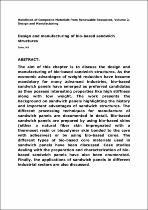JavaScript is disabled for your browser. Some features of this site may not work without it.
- ResearchSpace
- →
- Research Publications/Outputs
- →
- Book Chapters
- →
- View Item
| dc.contributor.author |
John, Maya J

|
|
| dc.date.accessioned | 2017-06-15T06:26:23Z | |
| dc.date.available | 2017-06-15T06:26:23Z | |
| dc.date.issued | 2017-03 | |
| dc.identifier.citation | John, MJ. 2017. Design and manufacturing of bio-based sandwich structures. In: Thakur, V.K., Thakur, M.K. and Kessler, M.R. (eds). Handbook of Composite Materials from Renewable Resources, Volume 2, Design and Manufacturing. | en_US |
| dc.identifier.isbn | 978-1-119-22362-7 | |
| dc.identifier.uri | http://eu.wiley.com/WileyCDA/WileyTitle/productCd-1119223652.html | |
| dc.identifier.uri | http://hdl.handle.net/10204/9269 | |
| dc.description | Copyright: 2017 Scrivener Publishing LLC. Due to copyright restrictions, the attached PDF file only contains the abstract of the full text item. For access to the full text item, kindly consult the publisher's website. | en_US |
| dc.description.abstract | The aim of this chapter is to discuss the design and manufacturing of bio-based sandwich structures. As the economic advantages of weight reduction have become mandatory for many advanced industries, bio-based sandwich panels have emerged as preferred candidates as they possess interesting properties like high stiffness along with low weight. The work presents the background on sandwich panels highlighting the history and important advantages of sandwich structures. The different processing techniques for manufacture of sandwich panels are documented in detail. Bio-based sandwich panels are prepared by using bio-based skins (either a natural fiber skin impregnated with a thermoset resin or biopolymer skin bonded to the core with adhesives) or by using bio-based cores. The different types of bio-based core materials used in sandwich panels have been discussed. Case studies dealing with the preparation and characterization of bio-based sandwich panels have also been enumerated. Finally, the applications of sandwich panels in different industrial sectors are also discussed. | en_US |
| dc.language.iso | en | en_US |
| dc.publisher | Wiley. Scrivener Publishing. | en_US |
| dc.relation.ispartofseries | Worklist;18413 | |
| dc.relation.ispartofseries | Worklist;18412 | |
| dc.subject | Biofillers | en_US |
| dc.subject | Biodegradability | en_US |
| dc.subject | Biopolymers | en_US |
| dc.subject | Cellulose | en_US |
| dc.title | Design and manufacturing of bio-based sandwich structures | en_US |
| dc.type | Book Chapter | en_US |
| dc.identifier.apacitation | John, M. J. (2017). Design and manufacturing of bio-Based sandwich structures., <i>Worklist;18413</i> Wiley. Scrivener Publishing.. http://hdl.handle.net/10204/9269 | en_ZA |
| dc.identifier.chicagocitation | John, Maya J. "Design and manufacturing of bio-based sandwich structures" In <i>WORKLIST;18413</i>, n.p.: Wiley. Scrivener Publishing.. 2017. http://hdl.handle.net/10204/9269. | en_ZA |
| dc.identifier.vancouvercitation | John MJ. Design and manufacturing of bio-based sandwich structures.. Worklist;18413. [place unknown]: Wiley. Scrivener Publishing.; 2017. [cited yyyy month dd]. http://hdl.handle.net/10204/9269. | en_ZA |
| dc.identifier.ris | TY - Book Chapter AU - John, Maya J AB - The aim of this chapter is to discuss the design and manufacturing of bio-based sandwich structures. As the economic advantages of weight reduction have become mandatory for many advanced industries, bio-based sandwich panels have emerged as preferred candidates as they possess interesting properties like high stiffness along with low weight. The work presents the background on sandwich panels highlighting the history and important advantages of sandwich structures. The different processing techniques for manufacture of sandwich panels are documented in detail. Bio-based sandwich panels are prepared by using bio-based skins (either a natural fiber skin impregnated with a thermoset resin or biopolymer skin bonded to the core with adhesives) or by using bio-based cores. The different types of bio-based core materials used in sandwich panels have been discussed. Case studies dealing with the preparation and characterization of bio-based sandwich panels have also been enumerated. Finally, the applications of sandwich panels in different industrial sectors are also discussed. DA - 2017-03 DB - ResearchSpace DP - CSIR KW - Biofillers KW - Biodegradability KW - Biopolymers KW - Cellulose LK - https://researchspace.csir.co.za PY - 2017 SM - 978-1-119-22362-7 T1 - Design and manufacturing of bio-based sandwich structures TI - Design and manufacturing of bio-based sandwich structures UR - http://hdl.handle.net/10204/9269 ER - | en_ZA |






